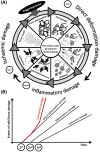Our contemporary understanding of the aetiology of pressure ulcers/pressure injuries
- PMID: 34382331
- PMCID: PMC8874092
- DOI: 10.1111/iwj.13667
Our contemporary understanding of the aetiology of pressure ulcers/pressure injuries
Abstract
In 2019, the third and updated edition of the Clinical Practice Guideline (CPG) on Prevention and Treatment of Pressure Ulcers/Injuries has been published. In addition to this most up-to-date evidence-based guidance for clinicians, related topics such as pressure ulcers (PUs)/pressure injuries (PIs) aetiology, classification, and future research needs were considered by the teams of experts. To elaborate on these topics, this is the third paper of a series of the CPG articles, which summarises the latest understanding of the aetiology of PUs/PIs with a special focus on the effects of soft tissue deformation. Sustained deformations of soft tissues cause initial cell death and tissue damage that ultimately may result in the formation of PUs/PIs. High tissue deformations result in cell damage on a microscopic level within just a few minutes, although it may take hours of sustained loading for the damage to become clinically visible. Superficial skin damage seems to be primarily caused by excessive shear strain/stress exposures, deeper PUs/PIs predominantly result from high pressures in combination with shear at the surface over bony prominences, or under stiff medical devices. Therefore, primary PU/PI prevention should aim for minimising deformations by either reducing the peak strain/stress values in tissues or decreasing the exposure time.
Keywords: aetiology; pressure injury; pressure ulcer; risk.
© 2021 The Authors. International Wound Journal published by Medicalhelplines.com Inc (3M) and John Wiley & Sons Ltd.
Conflict of interest statement
All authors were actively involved and contributed to the International Prevention and Treatment of Pressure Ulcers/Injuries: Clinical Practice Guideline 2019.
Figures


References
-
- EPUAP, NPIAP, PPPIA . Prevention and treatment of pressure ulcers/injuries: clinical practice guideline. In: Haesler E, ed. European Pressure Ulcer Advisory Panel, National Pressure Ulcer Advisory Panel, Pan Pacific Pressure Injury Alliance. EPUAP, NPIAP, PPPIA; 2019.
-
- Gefen A, Brienza D, Edsberg L, et al. The etiology of pressure injuries. In: Haesler E, ed. Prevention and Treatment of Pressure Ulcers/Injuries: Clinical Practice Guideline: European Pressure Ulcer Advisory Panel. Pan Pacific Pressure Injury Alliance: National Pressure Ulcer Advisory Panel; 2019.
-
- Kottner J, Cuddigan J, Carville K, et al. Prevention and treatment of pressure ulcers/injuries: the protocol for the second update of the international clinical practice guideline 2019. J Tissue Viability. 2019;28(2):51‐58. - PubMed
MeSH terms
LinkOut - more resources
Full Text Sources
Medical
Research Materials
Miscellaneous

